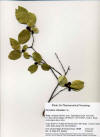|
Forestiera pubescens |
Forestiera pubescens
var. parviflora |
Forestiera pubescens
var. pubescens |
|
Forestiera reticulata |
|
|
|
Trees and Shrubs of Kern County (Jan 2013) Forestiera. Deciduous shrubs with opposite leaves often in clusters; flowers unisexual on same or different plants, without sepals, often without petals; fruit: drupe with 1 or 2 seeds. ±20 species, desert and tropical regions of the New World Forestiera pubescens Nuttall 1835 var. parviflora [Forestiera acuminata (Adelia acuminata Michaux 1803) Poiret 1812 var. parviflora A. Gray 1860) Nesom 2009 [Includes Forestiera neomexicana A. Gray 1876]. Desert olive. Large shrub or tree with a short trunk, densely branched from near base, branches opposite, rigid, often short—at right angles in the upper part of the plant; leaves deciduous, appearing with or after the flowers, in clusters (fascicles), short elliptical to spoon-shaped; flowers Mar-Apr, mostly unisexual on separate plants, occasional ones bisexual, sepals and petals lacking; fruit ovoid, fleshy (drupe), bluish black, 5–7 mm, 1-seeded. Scattered shrubs or massive thickets in washes, widely distributed from the valley to Colorado, Texas, and Mexico. Type from steep rocky banks of the Rio del Norte, near Santa Fe, NM]. Desert olive patches recognized in MCV2 when >50% relative cover in the shrub layer. Kern Co.: “Occasional in moist places in canyon bottoms from the desert ranges through the arid mountain slopes to the Temblor Range; west to Kernville” (Twisselmann). Thicket for nearly one-half mile in a steep ravine leading to Jawbone Canyon (pers. obs. 2011). The typical variety in Oklahoma, Texas and Mexico (Coahuila, Nuevo Leon).
|
||





